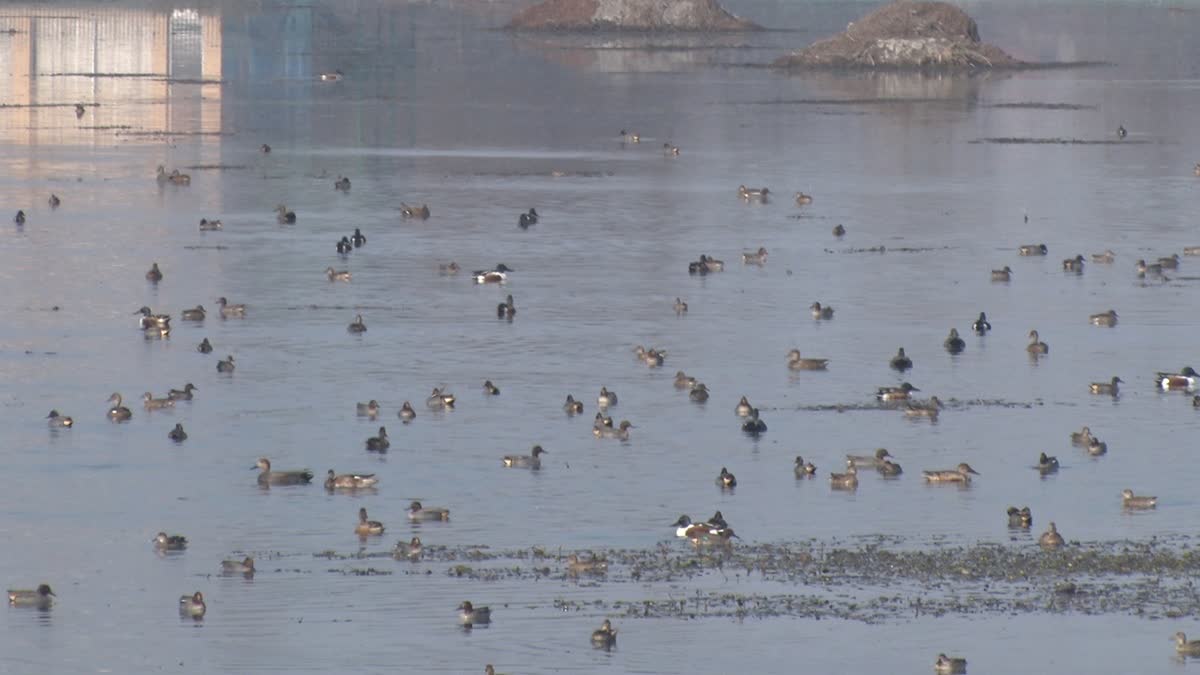Srinagar (Jammu and Kashmir): In spite of the prolonged dry spell that has gripped Kashmir, an impressive number of migratory birds have flocked to the region, upholding the centuries-old tradition of wintering in the wetlands. These avian visitors hail from diverse countries, including China, Russia, Japan, Central Asia, and various European nations. Of the approximately 400 lakes in Kashmir, 25 have been chosen by these migratory birds for their winter sojourn.
Ifshan Deewan, the Wildlife Warden of the Wetlands Division Kashmir, told ETV Bharat on phone that nearly 10 lakh migratory birds are currently present in all the wetlands of Kashmir, with no discernible impact from the dry spell. Contrary to expectations, the well-being of these migratory guests has not been compromised, thanks to ample water reserves in wetlands like Hokarsar and Shalbugh, which have provided a protective shield against adverse effects.
The total population of migratory birds gracing the wetlands of the Kashmir valley is estimated to be between 8 to 10 lakhs, with the Hokarsar wetland alone hosting 3 to 4 lakhs of these feathered visitors. Ifshan Deewan anticipates that the final figures will be available in February after a comprehensive census. Despite the dry spell, there has been no harmful impact on the wetlands, and the situation is being monitored on a daily basis.
The Wetlands Warden highlighted that the department has implemented multiple measures to transform all wetlands into habitable spaces, resulting in a noticeable surge in bird activity. She emphasized the significant reduction in poaching of migratory birds in recent years, attributing it to the department's efforts and the formation of dedicated teams to prevent poaching.
Last year, the Kashmir valley hosted more than 12 lakh migratory birds, some visiting for the first time. The department has taken several initiatives to maintain suitable habitats for these birds, ensuring an adequate water level in the wetlands. Apart from Hokarsar, other locations such as Wular Lake, Haigam, Shalbugh, Dal Lake, and Mirgund also attract migratory birds during the winter months.
- " class="align-text-top noRightClick twitterSection" data="">
Significantly, on August 15, the central government added two more wetlands, Shalbugh (in Ganderbal district) and Haigam (in Srinagar), to the list of Ramsar sites. This brings the total number of Ramsar sites in Jammu and Kashmir to five, with Hokarsar, Surinsar, and Wular Lake already included. Among the migratory birds that visit the valley annually are Tufted Duck, Gudwal, Brahminy Duck, Gargantuan, Greylag Goose, Mallard, Common Merganser, Northern Pintail, Common Pochard, Ferruginous Pochard, Red Crested Pochard, Ruddy Shelduck, Northern Shoveler, Common Teal, and Eurasian Wagtail.
These birds typically start their return journey from the valley in the last week of March.


